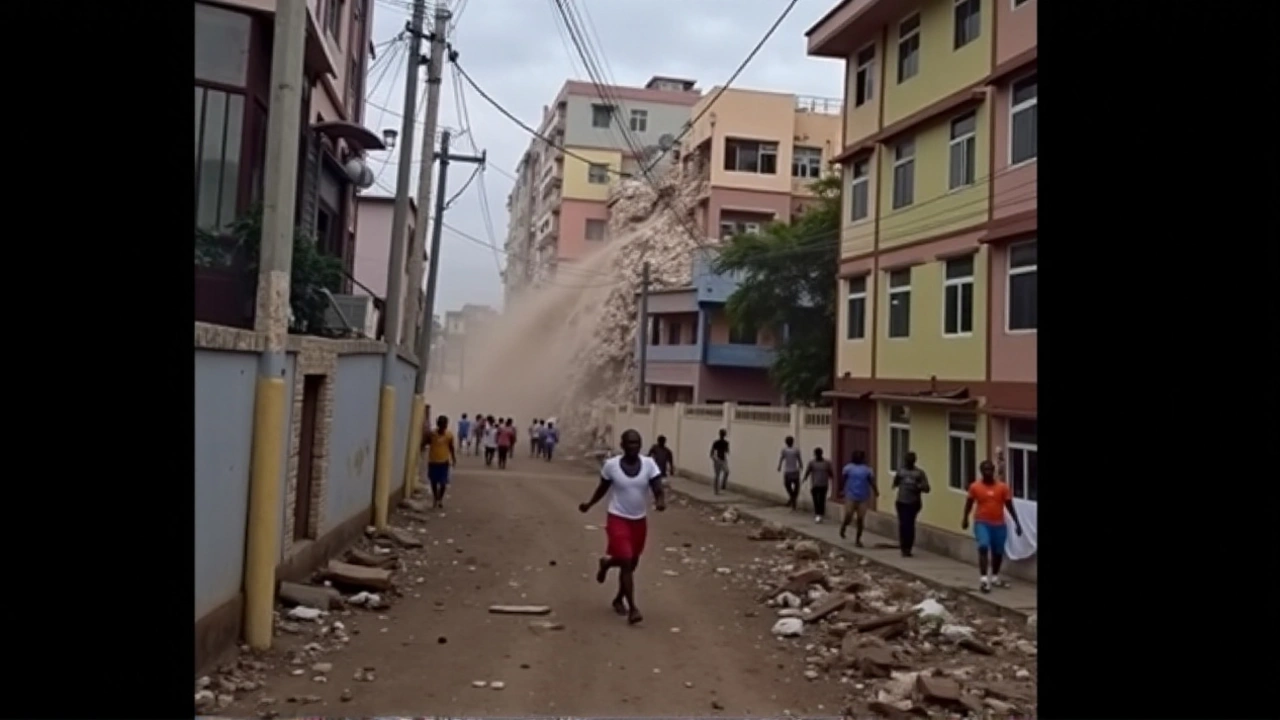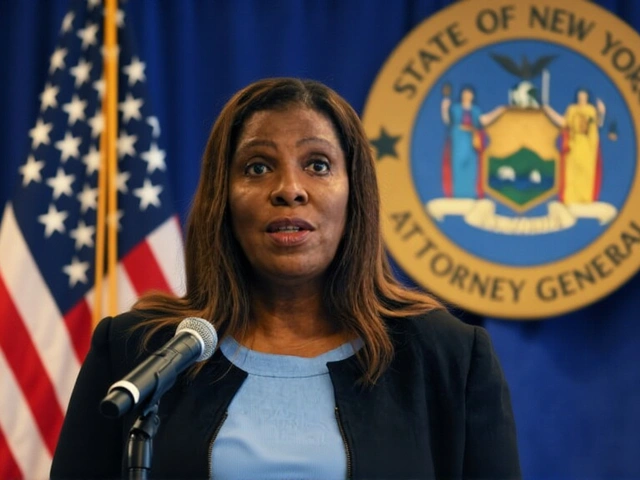Collapse of Multi-Storey Building in Nairobi's Kahawa West Sparks Urgent Rescue Efforts

Tragedy Strikes Kahawa West as Building Collapses
Early Sunday morning on October 20, 2024, a tragic event unfolded in the locality of Kahawa West, Nairobi, as a multi-storey building came crashing down. The exact time of the incident remains uncertain, but what is undeniably clear is the panic and fear it has instigated throughout the community. This unforeseen disaster left many occupants reportedly trapped beneath heaps of debris, their fate hanging in the balance as emergency services raced against time. Witnesses describe the scene as chaotic, with dust filling the air and screams echoing amid the falling rubble. The incident has not only drawn attention locally but has sparked concerns over infrastructure standards in the burgeoning city.
Rescue Efforts Underway Amidst Uncertainty
As news of the building's collapse spread, Nairobi's emergency response kicked into high gear. The Kenya Red Cross swiftly mobilized its team, closely followed by personnel from the Nairobi County Government. Arriving at the scene, the responders immediately began sifting through the rubble, utilizing every available resource to locate and extricate survivors. Their efforts are further complicated by the unknown number of people who were inside when the structure gave way. This ambiguity adds another layer of urgency, prompting authorities to deploy sniffer dogs and additional manpower to comb every corner of the collapsed building.
Community's Response and Evacuation Measures
The impact of the building's collapse rippled across the entire Kahawa West area. Families, friends, and neighbors gathered anxiously, hoping for any news of their loved ones. The Nairobi County Executive for Built Environment, Patrick Mbogo, addressed the media, offering reassurances that all steps were being taken to manage the crisis effectively. As a precautionary measure, he ordered the evacuation of residents from adjacent buildings, a move aimed at safeguarding them from potential dangers posed by structural instabilities. The tense atmosphere highlights the fragility of human constructs when faced with nature's unsettling force.
Root Causes and Future Preventive Measures
While rescue operations continue, questions regarding the root cause of the collapse have surfaced. Analysts point to several possibilities including poor construction practices, substandard materials, or even the impact of recent adverse weather conditions that may have weakened the building's integrity. The Kenyan government, alongside local authorities, has launched an investigation to determine the exact cause, hoping to prevent a recurrence of such tragic incidents. This investigation will likely scrutinize building codes and enforcement mechanisms to ensure that safer, more resilient structures are erected in the future.
Coordination and Support – A Collective Effort
In moments of crisis, the strength of a community is often tested. In Kahawa West, Nairobi, this resilience shone through as residents and authorities collectively worked hand in hand. Volunteers have pooled resources, offering food, water, and first aid supplies to both rescue workers and those affected by the collapse. This coordinated effort underscores the bond shared within the community, a reminder of the power that solidarity holds, especially in trying times. This spirit of togetherness is a beacon of hope amidst the shadows cast by the fallen edifice.
A Wait for More Information
As the dust slowly settles over the now-empty lot where the building once stood, the world watches for updates. Information remains sparse, but the dedication of the rescuers, paired with the community's unwavering support, stands as a testament to human endurance. As Kenya Red Cross engineers and county officials deliberate on the safest and most efficient mobilization strategies, loved ones clutch onto hope. Their patience, however understandable, is continually tested by the harrowing wait for definitive news.
The response to the Kahawa West building collapse serves as a formidable reminder of the progress and vigilance required in urban planning and maintenance. The incident's tragic outcome is felt across the hearts of many, a story that resonates with similar tales worldwide, where urban resilience and accountability are recurrent themes. Moving forward, the event stands as a tremendous learning opportunity, urging a collective rethink on how cities develop while safeguarding their citizens






Sally Sparrow
October 21, 2024 AT 03:08The Kahawa West collapse is yet another glaring example of how regulatory apathy can turn skyscrapers into ticking time bombs. Ignoring basic engineering standards isn’t just negligence-it’s a recipe for tragedy that cost lives. The fact that rescue crews are scrambling to find victims only underscores how little effort was put into preventing this disaster in the first place. Authorities need to stop patrolling the paperwork and start enforcing real inspections.
Eric Yee
October 22, 2024 AT 14:26Bro you gotta admit the city’s building oversight is a joke the whole thing could’ve been avoided if they bothered with proper permits and quality materials the red cross doing its best but they’re playing catch‑up after the fact
Sohila Sandher
October 24, 2024 AT 01:10Hey folks, stay strong and keep the hope alive you’re not alone we’re all sending positive vibes to the families and rescuers. Together we’ll get through this.
Anthony Morgano
October 25, 2024 AT 11:53Yo everyone, kudos to the volunteers and rescuers working nonstop 😅 they’re the real heroes pulling us through this nightmare 🙌 keep the love coming.
Holly B.
October 26, 2024 AT 22:36The coordinated effort between the Kenya Red Cross and local authorities demonstrates a commendable commitment to community safety and rapid response.
Lauren Markovic
October 28, 2024 AT 08:20For anyone looking to help, you can donate directly to the Kenya Red Cross via their official website or drop off supplies at the community centre in Kahawa West 😊 every little bit counts.
Kathryn Susan Jenifer
October 29, 2024 AT 19:03Well, isn’t this just the perfect plot twist we needed? A towering masterpiece reduced to rubble, and all we get are headlines screaming “disaster” while the real drama is the bureaucrats pretending they didn’t see it coming. Bravo, civilization, bravo.
Jordan Bowens
October 31, 2024 AT 05:46Another day, another disaster.
Kimberly Hickam
November 1, 2024 AT 16:30When we examine the Kahawa West collapse, we must first acknowledge that the tragedy is not an isolated incident but part of a broader pattern of infrastructural decay that plagues rapidly urbanizing regions. The underlying causes are multi‑faceted, ranging from corrupt procurement processes to the use of substandard concrete that fails under stress. Moreover, the political will to enforce building codes has been consistently undermined by short‑term economic incentives that prioritize speed over safety. This systemic failure is exacerbated by a culture of impunity whereby offending contractors escape accountability through legal loopholes and patronage networks. The resulting edifices become stages for calamity, and the victims are invariably the most vulnerable-families who trust that their homes are safe. In the wake of such disasters, the immediate focus on rescue operations, while noble, should not distract from the imperative for long‑term reform. A rigorous audit of all recent constructions is essential, as is the establishment of an independent oversight body insulated from political pressure. The community’s response, though heart‑warming, cannot substitute for structural safeguards. We must also consider the role of climate change, as increased rainfall and temperature fluctuations stress aging materials beyond their design specifications. Urban planners ought to integrate resilience metrics into future projects, ensuring that buildings can withstand both natural and anthropogenic stresses. Education campaigns targeting both developers and the public can foster a culture of safety that demands compliance. International partners can offer technical assistance, but the responsibility ultimately lies with national and local governments to enforce standards. Transparency in the investigation process will restore public trust and deter future negligence. Finally, the victims’ families deserve not only immediate relief but also long‑term support to rebuild their lives, a commitment that must be codified in policy. Only through a concerted, multifaceted approach can we hope to prevent another Kahawa West tragedy.
Gift OLUWASANMI
November 3, 2024 AT 03:13One must concede that the collapse is a glaring symptom of a governance model that treats regulation as optional prose rather than binding law, a reality that elicits nothing short of contempt for the elitist echelons that profit from such negligence.
Keith Craft
November 4, 2024 AT 13:56Alas! The heavens weep for the shattered towers, and we, mere mortals, stand humbled before the relentless march of hubris that crumbles beneath its own weight.